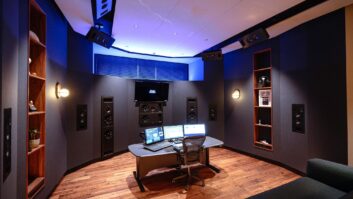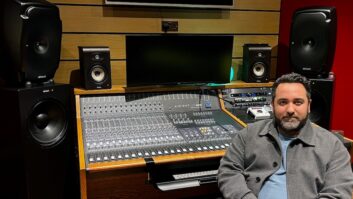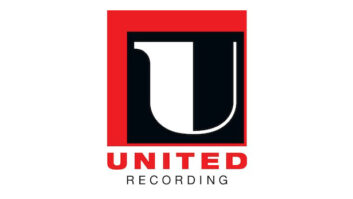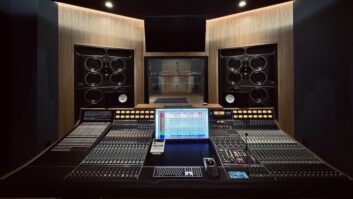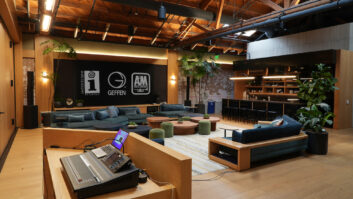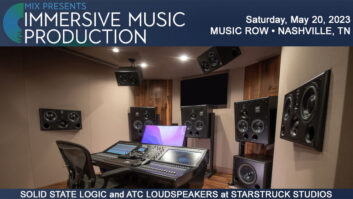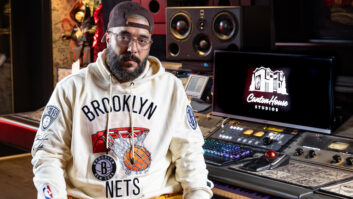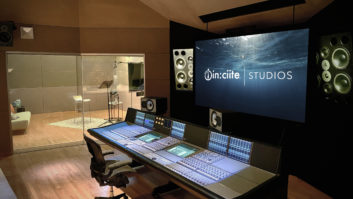Galaxy Studios is set on a quiet lane in Mol, in Flanders in north-central Belgium. Not much happens in this bucolic suburban town. That is, except for the occasional F-16 popping a wheelie overhead, a reminder that Brussels, an hour’s drive away, is the headquarters for NATO and the capital of the newly established European Union.
You’d be hard-pressed to hear anything emanating from Galaxy Studios’ 8,000-plus-square-foot edifice, though; in fact, it’s difficult to hear what’s going on in the next room, unless you pull up a fader. Galaxy’s design has achieved a benchmark in sound isolation, no mean feat when you consider that its design is not the product of any of the usual studio design gurus. Rather, it is the result of two brothers’ genuinely passionate pursuit of sonic purity.
The design is particularly impressive when you realize that a 100.7dB noise floor and an NC5 HVAC noise rating are consistent throughout all four main control rooms and all adjacent studio spaces, including a 1,000-square-foot main recording hall and several other music and post-production suites. If you want proof that goes beyond mathematical measurements, co-owners Wilfried and Guido Van Baelen are happy to step into one of the studios, close the airtight, concrete-filled door behind them, pull out a starter’s pistol (whose report comes in around 125 dB) and fire it. And if you hadn’t seen someone pull the trigger, you’d never know it happened.
FLYING THE COOPGalaxy started out in 1981 when the Van Baelens’ father turned what had been a poultry coop behind the family’s home into an ad hoc studio for Wilfried, a keyboard player and budding composer and producer. Guido pitched in on the effort, which began with an Otari 8-track deck and a Soundcraft Ghost console. Later, Wilfried started his own hi-fi retail business nearby, working on designs for the Wersi organ company.
After upping the technological ante with a 24-track MCI machine in 1984 and, later, a 56-input Amek Angela console, Wilfried, who was now also demonstrating organs and making recordings for Wersi while attending a music conservatory in Antwerp, wanted to start making records in his studio. It was then that he encountered noise issues for the first time. “I knew we needed to make the room quieter to make better recordings,” he recalls. “I talked to professors at my school, and they explained to me how I needed mass to stop noise. But we also started thinking about isolation ideas. We found this really thick rubber compound, and we covered the whole building with it, 2 centimeters thick. We had the best-isolated chicken coop in the world.” While Wilfried was delving deeply into direct MIDI-based recording-he was a beta tester for Cubase and owned one of the first Commodore computers in Europe-he was also peering into the mysteries of acoustic recording. “MIDI is great for a lot of things, but you don’t get emotion and expression across with it,” he says. “I had to learn to make good acoustic recordings.”
British pop dominated most of the European charts at the time, and the Van Baelens turned to UK studios for direction. But even the staid BBC’s definition of quiet wasn’t sufficient for Wilfried, who decided in 1988 to build his ideal recording space. He wanted a multiroom facility, one that would allow him to continue his burgeoning production career (he produces, among others, Belgian pop songstress Dana Winner, whom he married a year ago) and could still be booked regularly by outside clients. He wanted the studio to reach world-class status and draw work from around Europe and beyond.
David Hawkins of Eastlake Audio in the UK had befriended Wilfried and advised him that 60 to 70 dB of isolation would be about the best he could attain using conventional approaches to acoustical isolation, and that other solutions to acoustical crosstalk between rooms might work but would be cost-prohibitive for a recording studio. Back in Belgium, the Van Baelens took another route to see how far they could push the envelope, enlisting help from the academic and industrial sectors, from Professor Gerrit Vermeir at the Laboratory for Building Physics at Leuven University and Eric Desart, technical manager at Gerber Industries, both of whom also consulted with Hawkins. “Getting good isolation was the first challenge,” says Wilfried. “But we also had to consider how to keep an air conditioning system that could cool a building of that size inaudible, and also how to make all of this work in a friendly, creative environment.”
SOLUTIONSDesart devised a plan in which large helical springs, each capable of supporting 3.1 tons of load and with a resonance of 3 Hz, would be grouped and placed under the floor slabs of all of the studios and control rooms, which would in turn be isolated from each other via individual slabs and designed as free-standing concrete structures, which Van Baelen refers to as “bunkers.” For example, control rooms one, two and three weigh 252 tons each, and each has 78 springs supporting it. Vermeir calculated a compression of the spring of 25 millimeters initially, with another 2 mm of compression over the next 30 years from mathematically predictable metal fatigue-more than a lifetime for most recording studio enterprises.
“A helical steel spring has the advantage of higher insulation values than viscous elastic materials, but at the same time the disadvantage of extreme[ly] low internal damping,” Vermeir writes in an analysis of his recommendations. “Therefore, on the top and bottom of every spring package, an elastomer layer takes care of the natural frequency of the steel springs as well as the insulation of the high[er] frequencies.” The total weight these springs hold at Galaxy is a mind-boggling 2,030 tons-more than 4 million pounds-including concrete and equipment, and they can be seen in the labyrinth of tunnels that burrow under Galaxy, also holding wiring and amplifier cages.
Similar ingenious principles abound in other aspects of the design. The Van Baelens stressed the importance of sight lines between studios and control rooms. To achieve this and maintain isolation, incredibly heavy glass panes were specially made by a German manufacturer. The panes are fabricated from layers of glass and PVB foil to avoid the green-filtering effect common to thick aquarium glass-20 centimeters of glass plus vented gaps between them in each window.
The air conditioning was another major noise issue. The Van Baelens’ team devised a system of overhead venting with massive outlets in the large main recording hall and relatively large ones in all other acoustical spaces. Air is propelled by a series of large, low-pressure fans with 42 blades, augmented by large secondary baffled silencers, moving between 0.1 and 0.15 meters of air per second-slow enough to be virtually inaudible yet fast enough to recirculate the entire volume of the main recording hall completely three times per hour. The bottom line for Galaxy’s HVAC system is an NC rating of 5, lower than the specifications issued by both the BBC and Germany’s ARD broadcasting company.
However, each isolation solution created its own set of problems. For instance, the glass panes were so heavy-as much as a ton each-that they could not be mounted using conventional techniques. So, Guido devised a suction-based device to get around that. Overall, the implementation of the studio’s plans were so complex that construction contractors refused to bid a set price for the project; instead, they charged by the hour. And considering that Wilfried estimates that the entire project’s three phases took approximately 180,000 hours to complete, this understandably raised a few bank loan officers’ eyebrows.
With its cutting-edge and unconventional design, Galaxy is a natural magnet for new technologies. Starting late last year, technicians from Netherlands-based Philips, which is marketing the 1-bit DSD SACD format with co-developer Sony, have done several sessions at the facility, including classical releases for Cleveland-based audiophile label Telarc, engineered by 26-time Grammy winner Tony Faulkner and produced by James Mallison. And Galaxy’s technology complement puts it into the upper echelon that the Van Baelens had sought. Consoles include a Neve VR-P72 and a Capricorn, along with an SSL 9080J with a new 8-bus surround mix matrix. There is Genelec monitoring throughout. The facility also includes one of the largest main recording rooms on the continent, with flutter-free acoustics and a variable reverberation time between 1.6 and 2.6 seconds, along with significant recording spaces for all four main control rooms; Sonic Solutions systems for editing and mastering; wiring between all studios and the central machine room; and touches like individual lounges for each studio, a fitness facility, and a kitchen/dining/bar facility. Five on-site guest rooms, with more planned, make Galaxy a residential facility as well. Recent clients have included Lauryn Hill, Joan Osborne, Mary J. Blige, Kelly Family, Joe Zawinul and Rammstein. And with 75% of the studio’s business coming from outside of Belgium, the Van Baelens have also achieved the world-class status they had hoped for. Ronald Prent, who was at Galaxy doing 5.1 remixes with Rammstein, summed up a most complex facility most succinctly when he said, “Simply smashing.”
